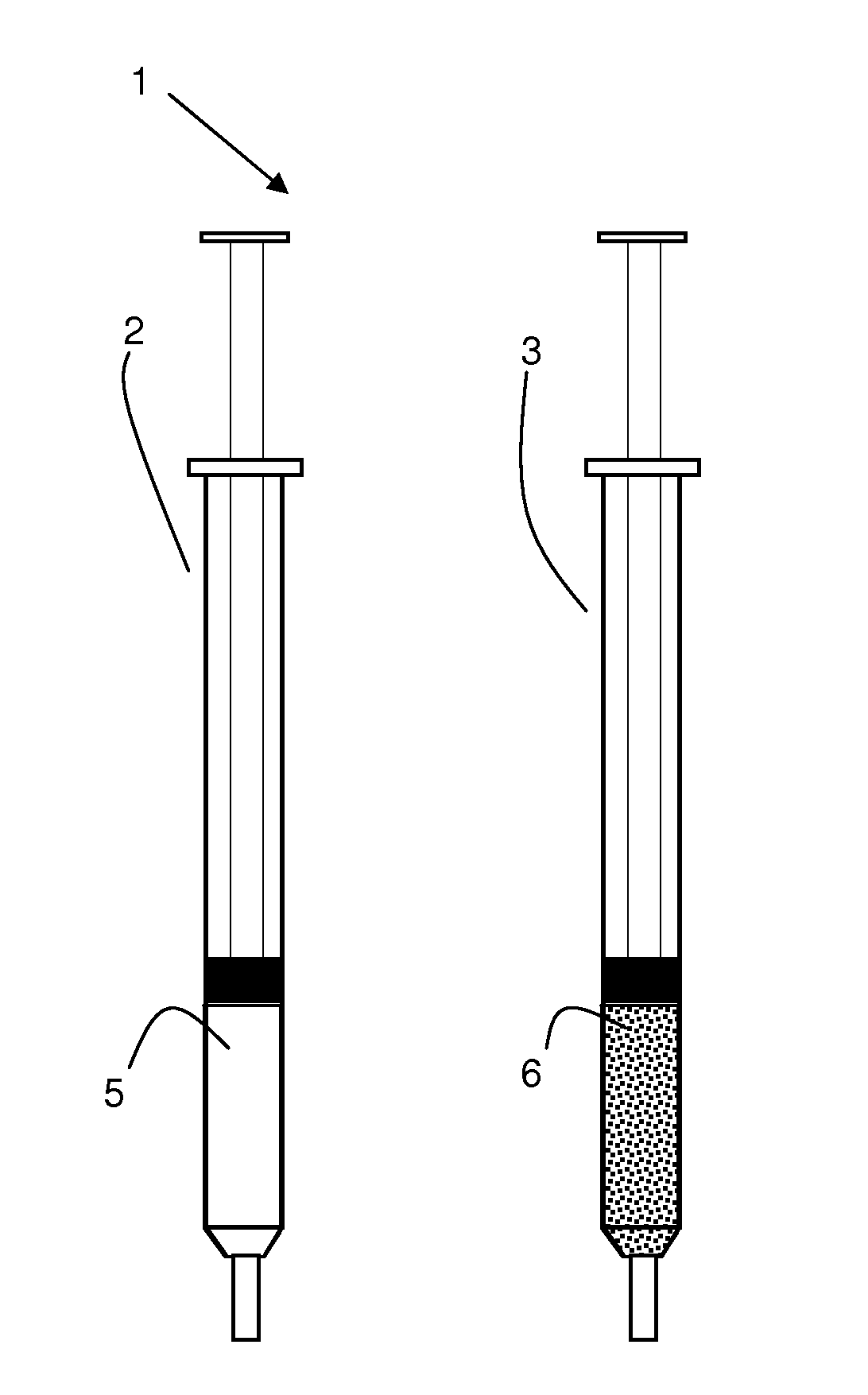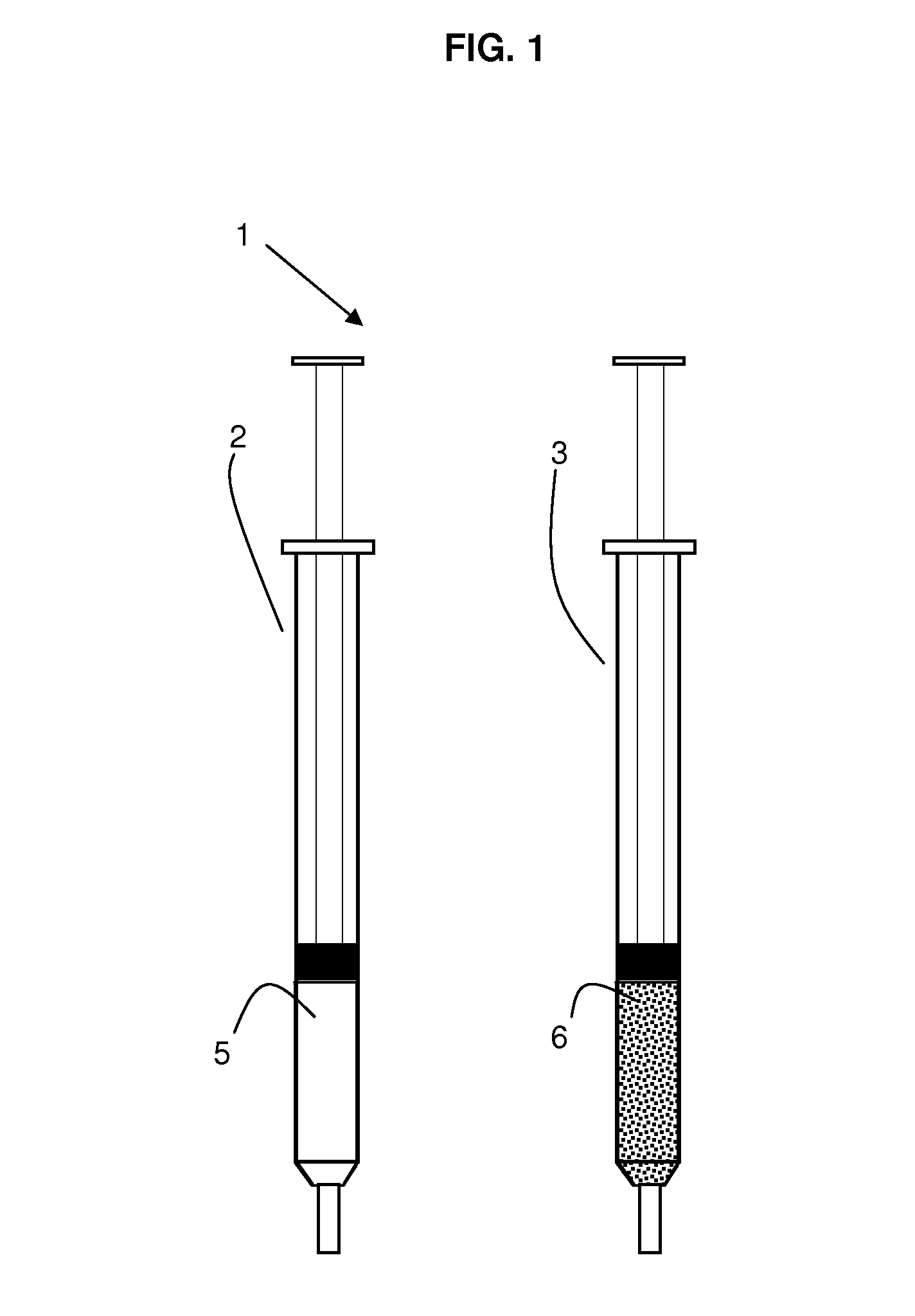Implants, particles
a technology applied in the field of implants and particles, can solve the problems of large solvent requirements, high patient undesiredness, and inability to transfer most microencapsulation techniques, and achieve the effect of reducing or eliminating the occurrence of stability problems
- Summary
- Abstract
- Description
- Claims
- Application Information
AI Technical Summary
Benefits of technology
Problems solved by technology
Method used
Image
Examples
example 1
[0066]Poly(d,l-lactide) (R 202H from Böhringer Ingelheim) in powder form and the solvent 2-pyrrolidone are separately filled in two syringes. The polymer is at least partially dissolved after connecting the syringes with a connector by pushing the syringe plungers forward and backward. The final polymer concentration in the carrier phase was 30% w / w. 130 mixing cycles (1 sec / cycle, 1 cycle equivalent to pushing the plungers forward and backward) were needed to obtain a polymer solution with the polymer powder used as received from the supplier. Milled polymer powder dissolved within 20 mixing cycles. Accordingly, a dissolution period of about 20 sec was obtained. Alternatively, the carrier phase can also be prepared within in a multi-chamber syringe. The polymer solution hardens in contact with pH 7.4 buffer, which simulates body fluids, and precipitates. The invention provides implants and particles that harden when exposed to a body fluid or physiological environment.
[0067]The car...
example 2
[0068]Poly(d,l-lactide) (PLA) (R 202 H, RG 752, RG 503, RG 503H from Böhringer Ingelheim) in solid form is obtained by lyophilization of an organic PLA-solution (e.g., in DMSO, dioxane, ethyl lactate or acetic acid at a concentration of 10 to 30% w / w) within one syringe which is then stored separately from the solvents 2-pyrrolidone, N-methyl-pyrrolidone, ethyl acetate or triacetin. The polymer is at least partially dissolved by the solvent after connecting the syringes with a connector and pushing the syringe plungers forward and backward. 10 to 50 cycles were needed to form the carrier phase with the different polymers and solvents. The final polymer concentration in the carrier phase was between 10 and 40% w / w. The polymer dissolved fastest (less mixing cycles needed) in ethyl acetate>N-methyl-pyrrolidone>2-pyrrolidone>triacetin. Accordingly, dissolution periods of less than 1 min or between 10 to 50 seconds were achieved. Alternatively, the carrier phase can also be prepared wit...
example 3
[0070]Poly(oxyethylene-oxypropylene) (Lutrol F127, BASF) powder [alternatively, poly(oxyethylene-oxypropylene) is obtained in solid form by lyophilization of an aqueous poly(oxyethylene-oxypropylene) solution) within a syringe] and water are separately filled in two syringes. The polymer is at least partially dissolved by the water after connecting the syringes with a connector and pushing the syringe plungers forward and backward. Alternatively, the carrier phase can also be prepared within in a multi-chamber syringe. Increasing the temperature to 37° C. leads to an increase in the viscosity of the polymer phase.
[0071]The carrier phase of above (in one syringe) is also dispersed in an external peanut oil phase, containing a stabilizer, if necessary, (in a second syringe) through a connector. Increasing the temperature to 37° C. leads to an increase in the viscosity of the carrier phase.
PUM
| Property | Measurement | Unit |
|---|---|---|
| pH | aaaaa | aaaaa |
| temperature | aaaaa | aaaaa |
| soluble | aaaaa | aaaaa |
Abstract
Description
Claims
Application Information
 Login to View More
Login to View More - R&D
- Intellectual Property
- Life Sciences
- Materials
- Tech Scout
- Unparalleled Data Quality
- Higher Quality Content
- 60% Fewer Hallucinations
Browse by: Latest US Patents, China's latest patents, Technical Efficacy Thesaurus, Application Domain, Technology Topic, Popular Technical Reports.
© 2025 PatSnap. All rights reserved.Legal|Privacy policy|Modern Slavery Act Transparency Statement|Sitemap|About US| Contact US: help@patsnap.com


